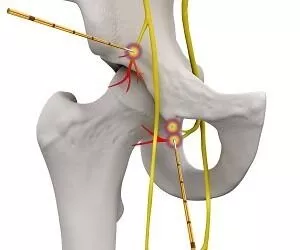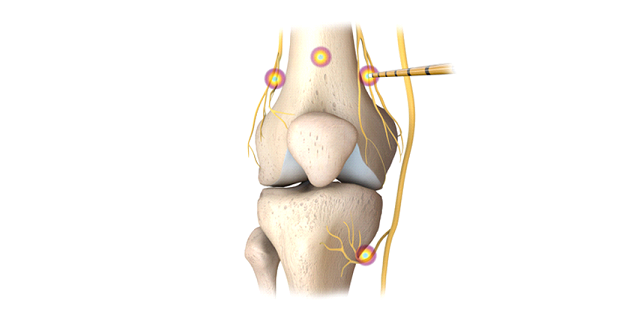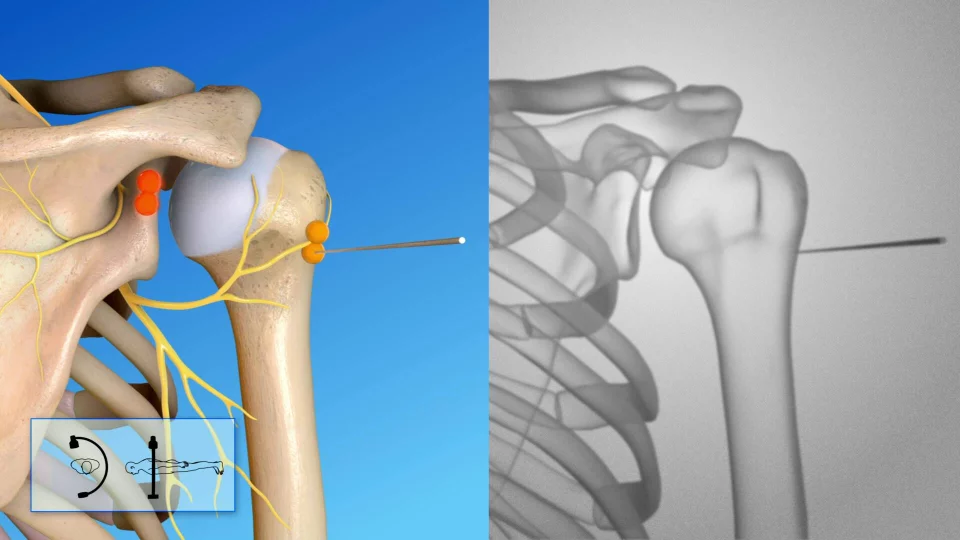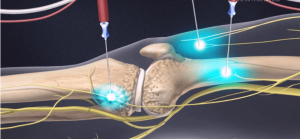COOLIEF Cooled Radiofrequency (RF) ablation
COOLIEF Cooled Radiofrequency (RF) ablation is a minimally invasive pain management procedure which targets and interrupts the transmission of pain signals from the knee, hip or shoulder.
How does the procedure work:
Several small needles, with a radiofrequency probe at their tip, are placed around your knee, hip or shoulder joint. These are placed at specific locations, under X-ray control, to target individual pain nerves to the relevant joint.
These probes are then connected to a power source which transmits a radio-frequency signal to the respective nerve.
The effect of the radiofrequency signal is to cause temporary thermal damage to the nerve. This interrupts the transmission of pain signals through those nerves to the brain and thereby reduces the perception of pain from that joint
Is there scientific evidence to support the use of Cooled RF ablation?
Yes. Several recent research studies have compared Cooled RF ablation to steroid and hyaluronic acid (Durolane, Synvisc) injections and found Cooled RF ablation to be more effective. The references are listed at the bottom of this page.
Is cooled RF ablation for me?
Dr Gomez feels that the ideal candidates for Coolief RF are
1. Patients with early arthritis who are not yet ready for joint replacement surgery.
2. Patients who are deemed too high risk for joint replacement surgery such as the very elderly, the obese and those with severe medical comorbidities such as serious heart or lung disease.
3. Patients who wish to delay their joint replacement surgery for any reason (such as work, travel etc), but would like to reduce their pain and improve their quality of life in the meantime.
Cooled RF ablation does not alter the disease process of arthritis in any way. It is simply a new method to decrease the transmission of pain signals from the painful arthritic joint. Total joint replacement (in appropriate candidates) will still provide more reliable, longer lasting symptom relief.


How long will the effects of the treatment last?
Studies have shown excellent pain reduction for between 12-24 months. The procedure can be repeated, with good results, if pain returns after this period.
What is the recovery period post treatment?
Due to the minimally invasive nature of this procedure, most patients can expect to feel pain relief within 1-2 weeks, allowing them to return to a better quality of life soon after the procedure.
Most patients can return to work within 24 – 72 hours of their procedure.
If you wish to discuss whether you may be a candidate for this procedure please contact my rooms on (07) 49221335.
References:
- Genicular Nerve Radiofrequency Ablation for Painful Knee Arthritis: The Why and the How. Kidd VD, Strum SR, Strum DS, Shah J. JBJS Essent Surg Tech. 2019 Mar 13;9(1):e10
- Cooled radiofrequency ablation of the genicular nerves for chronic pain due to osteoarthritis of the knee: a cost-effectiveness analysis based on trial data.,Desai M, Bentley A, Keck WA, Haag T, Taylor RS, Dakin H. BMC Musculoskelet Disord. 2019 Jun 26;20(1):302.
- Severity of Knee Osteoarthritis and Pain Relief After Cooled Radiofrequency Ablation of the Genicular Nerves. House LM, Korn MA, Garg A, Jung MJ, Kendall MC, Walega DR, McCormick ZL. Pain Med. 2019 May 2.
- Twelve-month analgesia and rescue, by cooled radiofrequency ablation treatment of osteoarthritic knee pain: results from a prospective, multicenter, randomized, cross-over trial. Davis T, Loudermilk E, DePalma M, Hunter C, Lindley DA, Patel N, Choi D, Soloman M, Gupta A, Desai M, Cook E, Kapural L. Reg Anesth Pain Med. 2019 Feb 16
- Cooled Radio Frequency Ablation for the Treatment of Osteoarthritis-Related Knee Pain: Evidence, Indications, and Outcomes.Oladeji LO, Cook JL. J Knee Surg. 2019 Jan;32(1):65-71.


